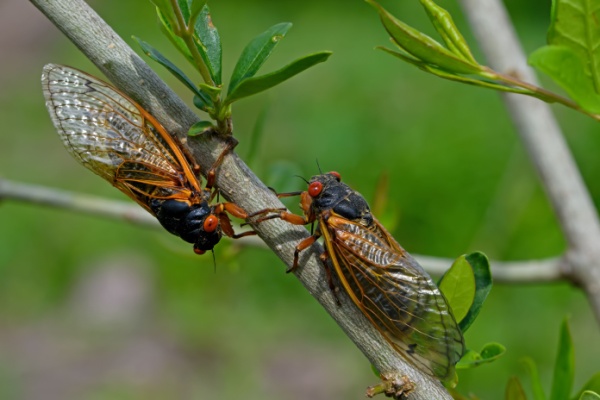A rare double-emergence of cicada broods is about to swarm the eastern United States in the coming weeks, scientists say.
As AccuWeather reports, Brood 13, which emerges every 17 years, and Brood 19, which emerges every 13, will join together for the first time since 1803. To put that into perspective, that’s when the Louisiana Purchase was signed, with Thomas Jefferson as president.
Cicadas, known for their loud chirping and tendency to leave behind mounds of exoskeletons, tend to surface around April or May to reproduce before disappearing again.
There are 15 “periodical” cicada broods in the United States, three of which emerge every 13 years and the rest every 17. The cicadas from Broods 13 and 19 are of a similar size, growing to about 1.4 inches, but other broods can double that and have up to an eight-inch wingspan.
Get ready, Illinois, because your state will be ground zero for this historic emergence, which is expected to sweep through about a dozen other states. The area with the greatest likelihood of overlap between the two broods is in Springfield, Ill. Shrader said the “bug geeks” are looking forward to seeing whether the two broods will hybridize during mating season.
Dr. Katie Dana, an entomologist and cicada expert from Illinois, said she’s been looking forward to this year’s co-emergence for many years. “I’ve been trying to spread the word — people haven’t listened until this year,” she told The Independent.
Entomologist Meredith Shrader at Auburn University said central and northern Alabama can expect “millions and millions” of cicadas for about six to eight weeks. “Everybody’s getting really, really excited,” Shrader told Al.com. “Some people are dreading it, but it’ll be fun.”
While the two broods are not expected to overlap to any significant extent, research from the University of Connecticut suggests if the two did produce hybrid offspring, they would emerge alongside the next generation of one or both of their parent broods and be indistinguishable from them.
While some people might dread the oncoming swarm and the damage to their ornamental plants, people in academia are embracing it as a once-in-a-lifetime phenomenon. One professor in Ohio created a free app, called Cicada Safari, for users to upload pictures and track where cicadas are emerging with the highest density.
While its hard to imagine cicadas being a threatened species, scientists warned of the possible effects of climate change on their population.
Dana said cicadas ensure their survival by producing so many offspring that their vast numbers overwhelm natural predators like birds, snakes and mammals, but even a small dip in a brood’s emergent population due to high temperatures or deforestation could cause predators to wipe them out entirely.
—
Photo Credit: Michael G McKinne / Shutterstock.com
